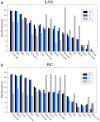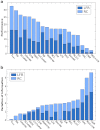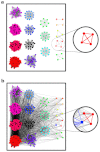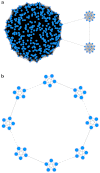Surprise maximization reveals the community structure of complex networks
- PMID: 23320141
- PMCID: PMC3544010
- DOI: 10.1038/srep01060
Surprise maximization reveals the community structure of complex networks
Abstract
How to determine the community structure of complex networks is an open question. It is critical to establish the best strategies for community detection in networks of unknown structure. Here, using standard synthetic benchmarks, we show that none of the algorithms hitherto developed for community structure characterization perform optimally. Significantly, evaluating the results according to their modularity, the most popular measure of the quality of a partition, systematically provides mistaken solutions. However, a novel quality function, called Surprise, can be used to elucidate which is the optimal division into communities. Consequently, we show that the best strategy to find the community structure of all the networks examined involves choosing among the solutions provided by multiple algorithms the one with the highest Surprise value. We conclude that Surprise maximization precisely reveals the community structure of complex networks.
Figures






Similar articles
-
Exploring the limits of community detection strategies in complex networks.Sci Rep. 2013;3:2216. doi: 10.1038/srep02216. Sci Rep. 2013. PMID: 23860510 Free PMC article.
-
Deciphering network community structure by surprise.PLoS One. 2011;6(9):e24195. doi: 10.1371/journal.pone.0024195. Epub 2011 Sep 1. PLoS One. 2011. PMID: 21909420 Free PMC article.
-
Detecting communities using asymptotical surprise.Phys Rev E Stat Nonlin Soft Matter Phys. 2015 Aug;92(2):022816. doi: 10.1103/PhysRevE.92.022816. Epub 2015 Aug 24. Phys Rev E Stat Nonlin Soft Matter Phys. 2015. PMID: 26382463
-
SurpriseMe: an integrated tool for network community structure characterization using Surprise maximization.Bioinformatics. 2014 Apr 1;30(7):1041-2. doi: 10.1093/bioinformatics/btt741. Epub 2013 Dec 20. Bioinformatics. 2014. PMID: 24363381
-
A DC programming approach for finding communities in networks.Neural Comput. 2014 Dec;26(12):2827-54. doi: 10.1162/NECO_a_00673. Epub 2014 Sep 23. Neural Comput. 2014. PMID: 25248085
Cited by
-
Identification of leader and self-organizing communities in complex networks.Sci Rep. 2017 Apr 6;7(1):704. doi: 10.1038/s41598-017-00718-3. Sci Rep. 2017. PMID: 28386089 Free PMC article.
-
Critical analysis of (Quasi-)Surprise for community detection in complex networks.Sci Rep. 2018 Sep 27;8(1):14459. doi: 10.1038/s41598-018-32582-0. Sci Rep. 2018. PMID: 30262896 Free PMC article.
-
Robust, scalable, and informative clustering for diverse biological networks.Genome Biol. 2023 Oct 12;24(1):228. doi: 10.1186/s13059-023-03062-0. Genome Biol. 2023. PMID: 37828545 Free PMC article.
-
Community detection in weighted brain connectivity networks beyond the resolution limit.Neuroimage. 2017 Feb 1;146:28-39. doi: 10.1016/j.neuroimage.2016.11.026. Epub 2016 Nov 16. Neuroimage. 2017. PMID: 27865921 Free PMC article.
-
Global vs local modularity for network community detection.PLoS One. 2018 Oct 29;13(10):e0205284. doi: 10.1371/journal.pone.0205284. eCollection 2018. PLoS One. 2018. PMID: 30372429 Free PMC article.
References
-
- Wasserman S. & Faust K. Social Network Analysis: Methods and Applications. (Cambridge University Press, 1994).
-
- Strogatz S. H. Exploring complex networks. Nature 410, 268–276 (2001). - PubMed
-
- Barabási A.-L. & Oltvai Z. N. Network biology: understanding the cell's functional organization. Nat. Rev. Genet. 5, 101–113 (2004). - PubMed
-
- Costa L. D. F., Rodrigues F. A., Travieso G. & Boas P. R. V. Characterization of complex networks: A survey of measurements. Adv. Phys. 56, 167 (2007).
-
- Newman M. E. J. Networks: An Introduction (Oxford University Press, 2010).
Publication types
LinkOut - more resources
Full Text Sources
Other Literature Sources

